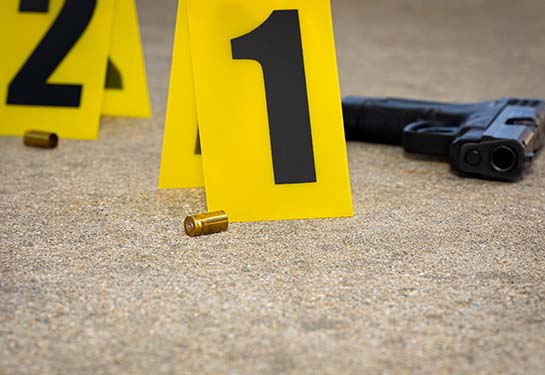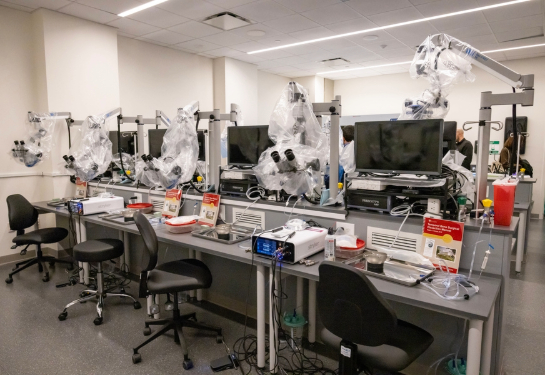Extreme risk protection orders to prevent mass shootings: What does the research show?
Mass shootings are a source of shared anguish and outrage among Americans and are becoming more frequent. Extreme risk protection orders (ERPOs), also known as gun violence restraining orders or “red flag” laws, are designed to help prevent these shootings. Below, UC Davis Violence Prevention Research Program (VPRP) experts explain what is currently known about mass shootings, how ERPOs work and the effectiveness of ERPOs in preventing harm to others and self-harm.
The information cites research using various definitions of mass shootings. Please note that not all statistics can be directly compared. A PDF of the full memo can be downloaded here.
Key takeaways
- Mass shooters frequently share their plans, creating opportunities to intervene
- ERPOs are temporary, tailored interventions focused on high-risk individuals
- Research indicates ERPOs can prevent both mass shootings and suicides
- ERPOs are widely supported by the general public, including most gun owners
- Resources are needed to improve training and implementation related to ERPOs
Background: mass shootings and their perpetrators
There is no universally accepted definition of a mass shooting – counts vary drastically. An often-cited, broad measure counts mass shootings as when four or more people, excluding the shooter, are shot or killed in one event. From January 1 to June 5, 2022, there have been 246 such incidents. Many researchers use other measures, for example including only shootings in public places or when four or more people are killed, or excluding those occurring in the context of other criminal activity.
Mass shootings are rare but increasing. Only about 1% of all firearm-related deaths (2 to 3% of firearm homicides) occur in mass shootings. While rare, the frequency and death toll of mass shootings are rising.
Mass shooters often share their plans and exhibit dangerous behaviors and warning signs. Approximately half of public mass shooters — and almost all school shooters — "leak” their plans to others. The majority of mass attackers (65-93%) engage in some form of threatening or concerning communications before the incident. At least one-quarter are motivated by ideologies such as white supremacy, misogyny, and xenophobia.
Mass shooters often have a history of violence towards others, including domestic violence. One study found that nearly 70% of fatal mass shootings were related to domestic violence, or the shooter had a history of domestic violence. Although some experience mental health problems, most mass shooters do not meet the criteria for involuntary psychiatric hospitalization and are thus not subject to associated firearms prohibitions.
People often recognize concerning behaviors, providing opportunities for intervention. At least two-thirds of mass attackers exhibit behaviors that elicit concern in family members, friends, neighbors, classmates, co-workers, or others. Unpublished research from the UC Davis Violence Prevention Research Program estimates that one in five adults in California personally know someone they perceive to be at risk of harming themselves or others; an estimated 130,000 Californians know a person who has made threats of mass violence.
What are extreme risk protection orders (ERPOs)?
ERPOs were created to prevent mass shootings. An ERPO is a civil court order that temporarily prevents a person at risk of hurting themselves or others from possessing or purchasing firearms and ammunition. ERPO is an umbrella term for temporary risk-based firearm removal policies. These policies and their names differ by state. In California, ERPOs are known as gun violence restraining orders or GVROs. ERPO laws were designed to prevent — and are often adopted in response to — mass shootings. To date, 19 states and the District of Columbia have ERPO laws, mostly enacted since 2016.
ERPOs must be based on key behavioral warning signs and ordered by a judge. An ERPO is initiated via petition by law enforcement or, in some states, by family, household members, or other eligible petitioners, and issued by a judge who considers evidence of the respondent’s danger to self or others. Such evidence may include recent acts or threats of violence toward self or others, a history of threatening or dangerous behaviors, and the recent acquisition of firearms or ammunition. A psychiatric diagnosis is not recommended for consideration.
ERPOs are civil orders with protections for respondents, including due process. ERPOs do not create criminal records unless an order is violated. Due process protections are built-in for both emergency ex parte orders (typically lasting 2 to 3 weeks) and longer-term orders (typically lasting up to one year); the latter are only issued after notice and a hearing. Many states have criminal penalties for knowingly filing a false or harassing petition, and research suggests that such misuse is extremely rare.
Do ERPOs prevent violence?
ERPOs are successful in cases of threatened violence. ERPOs are overwhelmingly being used as intended, intervening in cases of threatened self- or other-directed violence, including mass shootings. ERPO petitions are usually filed by law enforcement, and the majority are granted. When petitions are denied, it is most often because they do not meet the required burden of proof. In most cases, firearms are recovered by or turned in to law enforcement, though ERPOs are also used to prevent respondents from purchasing new firearms.
Deaths among respondents are rare post-ERPO. Among ERPO cases in California from 2016-2018, with follow-up for 379 respondents, one died from firearm injuries sustained in a suicide attempt that prompted the order to be requested; no other respondents died by suicide using firearms or other means after being issued an ERPO.
ERPOs have been used to stop potential mass shootings. In the first three years of California’s ERPO law, 58 cases involved threatened mass shootings, including six that involved minors targeting schools. A separate in-depth analysis of 21 of these cases found that none of the threatened shootings had occurred, nor had there been other homicides or suicides by the respondents.
ERPOs protect individuals, but it may be too early to see the change in the population. Studies of individual-level outcomes found that ERPO laws in Connecticut and Indiana are effective for suicide prevention, estimating that one life is saved for every 10-20 orders issued. The findings of population-level studies are mixed.
Does the general public support ERPOs?
Public support for ERPO policies is high. Survey data show that a strong majority of Americans support the concept of ERPOs, irrespective of political party or gun ownership status. When Californians were asked about ERPOs, 80-85% of firearm owners agreed that ERPOs are at least sometimes appropriate in 4 of 5 risk scenarios (such as threats of harm to self, others or groups of people). This is even higher than the 72-78% agreement by non-owners and 76-85% by non-owners who live with owners.
Public willingness to use an ERPO is high. Depending on the scenario, 73-84% of adults in California say they would be somewhat or very willing to personally petition for an ERPO for an at-risk family member. Non-gun owners who live with firearm owners report the highest levels of willingness (84-95%).
Public perception and use of ERPOs vary by race and ethnicity. Research from California suggests that support for and personal willingness to use ERPOs is lower among Black and Hispanic/Latinx adults, who most often cite a lack of knowledge about ERPOs, distrust that the system will be fair, or the belief that these are personal/family matters. Among 193 ERPO respondents between 2016-2018, no family or household members served as petitioners for Black and Hispanic/Latinx respondents.
What is needed to improve ERPO implementation?
Robust implementation support is key. Within states, there is substantial local variation in ERPO use. Local champions drive uptake. Interviews with stakeholders, including judges, law enforcement officers, city and district attorneys, and policy experts, have indicated that funding and guidance to support local implementation efforts can lead to clearer and more consistent practices. Pairing law enforcement with other professionals (e.g., social workers) in serving ERPOs may promote racial equity and connect respondents to support services.
Professionals who may petition for ERPOs need and want training. Most ERPO petitioners are law enforcement, but in a survey of officers in states with ERPO laws, only 55% had received training. Most healthcare providers surveyed in Washington and Maryland reported being willing to contact law enforcement to file a petition or file a petition directly but desired additional support and training.






